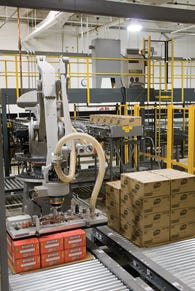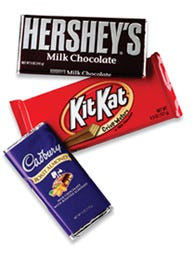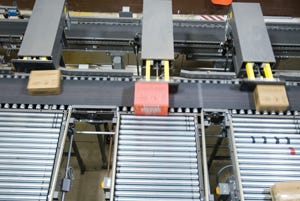Automated palletizing system provides 'sweet' relief for Hershey
At the Hershey Foods Corp. manufacturing facility where packaging-systems engineer Alex Diaz works, (Hershey prefers not to disclose the location of this facility), the only constant is change. The plant manufactures Hershey products for an assortment of brands including Hershey®'s, Kit Kat® and Cadbury®, with a wide variety of low- to mid-velocity stockkeeping units (SKUs) that can change seasonally, weekly and even daily, based on demand from the Hershey marketing team, retail stores and consumers. For a company demanding this much flexibility, its packaging, logistics, and material handling solutions must be up to the task. This was the challenge when the Hershey engineering group looked to material-handling integrator FKI Logistex (www.fkilogistex.com) to successfully revamp and automate the palletizing operations at the Hershey facility.
Until 2005, everything at the Hershey plant was hand-palletized, resulting in low palletizing rates and high manual labor costs. “We had three to four people palletizing per line, per shift, for three shifts a day,” says Diaz. “So we're talking about twelve to fifteen people palletizing at once.” Employees were also doing a lot of heavy lifting—some boxes in excess of fifty pounds—leading to ergonomic issues and safety concerns. When Hershey's increasingly wide variety of product SKUs and packaging configurations started to require faster and more flexible palletizing, Diaz and fellow Hershey engineers knew it was time to make the switch to an automated system. Automated palletizing promised increased capacity, decreased labor costs, a safer work environment and the versatility Hershey required for its diverse product line.
Diaz, along with project manager Dennis Empson and staff engineer Matt Eroh, teamed up with long-time material-handling supplier FKI Logistex to design an automated palletizing system that could handle Hershey's low- to mid-velocity SKUs, that range from one to 40 cases/min.

Three robotic palletizers each receive product on three separate conveyors and palletize in three different positions at once.
Keeping in mind that the entire system would need to fit within the tight space constraints of the plant's approximately 7,000-sq-ft palletizing area, the team weighed their two best options—conventional and robotic palletizing. Almost immediately, it became clear that conventional palletizing, while fast and cost-effective, would not work with Hershey's space restrictions. “To implement a multiline system with conventional palletizers, you need enough accumulation conveyors to accommodate up to two full pallet-loads on each line, depending on load lengths and production rates,” explains Mark Conreux, the senior project manager from FKI Logistex. “Hershey's eight production lines required significantly more conveyor than they had space to accommodate.”
Robotic and conventional palletizing
Robotic palletizing, on the other hand, offered a more versatile option by enabling Hershey to send three different lines to one robot and palletize in three different positions at once. This greatly reduced the amount of conveyor required, but posed a problem of its own—the robots could not keep up with the production rates of Hershey's higher-velocity skus. Hershey and FKI Logistex quickly realized that a combination of robotic and conventional palletizing was the best solution to meet Hershey's requirements, given the limited floor space available. The team worked together to design a system that sends mid- to high-velocity SKUs to an FKI Logistex A-780 case palletizer, and low-velocity SKUs to one of three EPL 160 jointed-arm robots from Motoman, Inc. (www.motoman.com).
A partnership between FKI Logistex and Motoman, Inc. facilitated Hershey's transition to robotic palletizing, a technology not previously introduced in this facility. “Most companies focus their expertise on either conventional or robotic palletizing,” says Diaz. “But the experience FKI Logistex has with both technologies made the integration very easy and was the main reason that we chose to use a combination of both to meet our palletizing requirements.” According to Conreux, who has personally overseen the installation of many conventional palletizers and robots, putting them together just made sense. “We gave Hershey the best of both worlds and developed a unique palletizing solution for its product line,” he says.
Wide range of technologies
The new system includes a wide range of FKI Logistex technologies, including the A-780 case palletizer, a photo-eye Accuglide™ accumulation conveyor, gravity roller conveyors, chain-driven live-roller conveyors and motor-operated turntables, a high-speed, laser-positioned transfer car and high-speed v-belt live-roller conveyors. The stand-alone programmable-logic control system features fully customized code work by FKI Logistex. Diaz and his team were especially impressed with the FKI Logistex photo-eye Accuglide powered roller conveyor, which provides zero-pressure accumulation of cartons. “The Accuglide conveyors are excellent,” says Diaz. “And the fact that FKI Logistex was able to integrate all their conveyors with the rest of their equipment made it much easier for us to get the complete package.”
Conreux adds that FKI Logistex offered Hershey a wide product line from which to choose the equipment that best suited its requirements for the lowest cost. “A lot of integrators make the same claim, but they do not manufacture all of the equipment. Many times they force their limited product line into an application instead of applying the best available solution. At FKI Logistex, we manufacture a wide range of products, giving us the flexibility to provide exactly what the customer requires.”
Conreux notes that one of the biggest challenges of the project was finding an end-of-arm tool for the robots that could handle Hershey's wide variety of sku sizes and weights. Although FKI Logistex typically designs and manufactures the tooling for the robots they integrate, Conreux and his team decided to outsource the end-of-arm tool based on the product specifications for this project. They chose to use a UniGripper® flexible vacuum tool from Tepro Machine & Pac System (www.tepro.nu), which activates specific vacuum areas to create the necessary lifting forces for each package, based on the shape and location of cases programmed into the system. “I've installed some other robots, and this was by far the easiest to use and most versatile end-of-arm tool I have ever worked with,” says Empson.
The new palletizing system gives Hershey the capability to easily integrate the remaining hand-palletized lines into the automated system by adding a spur conveyor and possibly a fourth robot, based on future demand. This built-in flexibility is something that Diaz agrees should be standard on all material-handling systems. “Most of the SKUs that we started the project with were not being produced by the time we got the system running,” says Diaz. Three new patterns were added to the A-780 palletizer before FKI Logistex even arrived onsite, and up to 50 percent of product sizes and patterns were changed before installation was complete. Because of these changes, Hershey commissioned FKI Logistex to install pattern generation software for the A-780, which Hershey had chosen not to include in the original system design.
“At first, when our packaging department came to us with a new pattern, we had to e-mail it to FKI Logistex to make changes to the PLC's code,” explains Diaz. “This process required an engineer to analyze the new pattern requirements, ensure that existing patterns would not be adversely affected, program the changes and then upload the code back to us. With the FKI Logistex pattern-generation software, the Hershey plant operator can directly program the new pattern into the palletizer, test it and have it operational in a matter of hours.”
Software offers flexibility
The FKI Logistex pattern-generation software is controlled by an easy-to-use touchscreen display directly connected to the A-780. Hershey plant operators can add new patterns and make changes in real time. “The pattern-generation software is a recommendation I would give anyone for this type of system,” continues Diaz. “It gives us the flexibility to make changes ourselves and get the new packaging configurations up and running quickly. With six new SKUs, it pays for itself.”
As part of the contract, FKI Logistex provided on-site training on the new system to Hershey personnel. Select Hershey mechanics also visited Motoman for additional training on the robotic palletizers. More than 30 Hershey employees received training, including all of the plant's forklift operators and electrical technicians. “Once we reached the point where the operators were comfortable with the system, we've been running efficiently,” says Diaz. “And the fact that Hershey has yet to call FKI Logistex to make adjustments to the system is a testament to just how well the training worked,” adds Empson.
Aggressive timeline
Hershey and FKI Logistex faced an aggressive timeline for installation of the new palletizing system. Once the installation process began, the Hershey team tore out conveyors, vacuum lifts and other hand-palletizing equipment. Crews worked multiple shifts and overtime in a very tight space, but their hard work paid off. “We installed the entire system in five weeks and had it commissioned in three and a half weeks,” says Diaz. Working long hours, Hershey engineers checked the wiring of the entire system in less than three days, an impressive feat. FKI Logistex provided Hershey with technical support during installation and commissioning to help the team get the project completed. “We had an FKI Logistex customer-service engineer come out, who was excellent on both the conventional palletizer and the robot,” says Diaz. “He got up to speed very quickly and worked with us to move the project to completion.”

Cases on the conveyor are diverted onto conveyors feeding the robotic palletizers. The system is controlled by a stand-alone programmable-logic control system with customized code work.
Since the completion of the project in June 2006, Hershey has seen increases in palletizing speed and efficiency, and has had no major problems with the equipment or the system itself to report. The equipment, which has proven to be reliable, is saving Hershey a great deal of money on manual labor costs, as well as greater potential savings from reduced ergonomic complaints.
Hershey engineers are happy with the system's performance, and Empson has called the palletizing solution the “latest and greatest” in Hershey material handling systems. Conreux agrees that this has been a very successful project for everyone involved. “We would certainly do this type of project for Hershey again.”
Throughout the course of his first major material handling-project, Diaz says he learned a lot about adapting to new technologies and being prepared for future change. “Basically, nearly everything you plan has changed by the time you implement it,” notes Diaz, referring to the constant packaging changes he faced during the project. “Change comes quickly,” he continues, “and you have to adapt to it as quickly as possible to be successful.”
More information is available: |
FKI Logistex, 877/935-4564. www.fkilogistex.com. |
Motoman, Inc., 937/847-3200. www.motoman.com. |
Tepro Machine and Pac System AB, 46/560-27270. www.tepro.nu. |
About the Author(s)
You May Also Like


